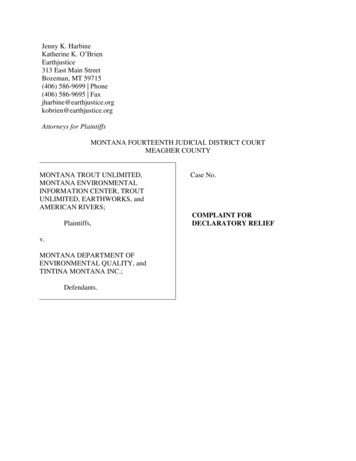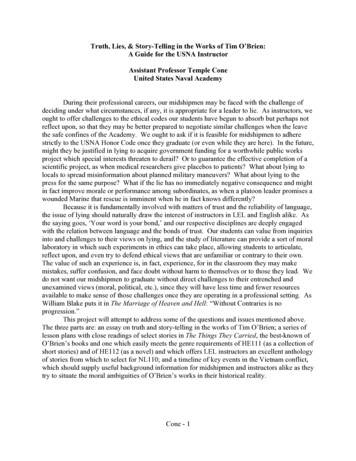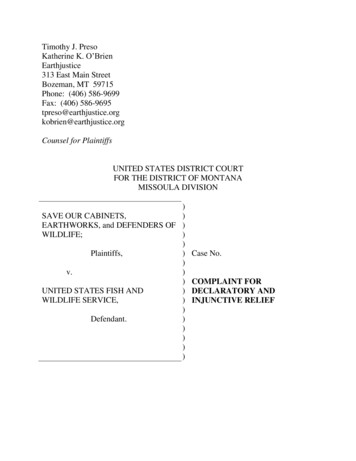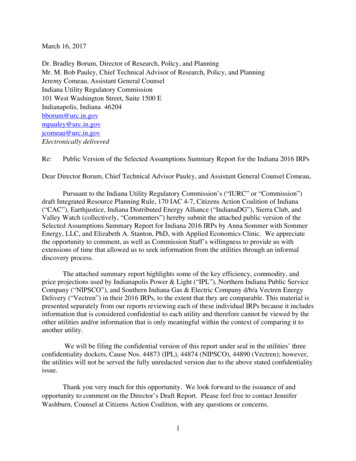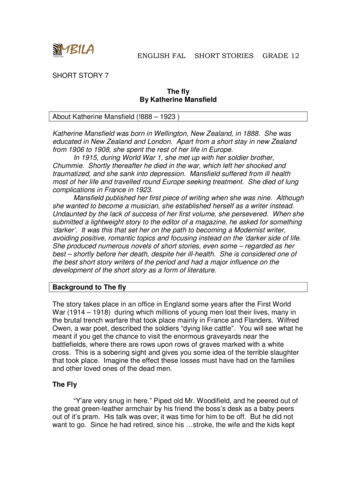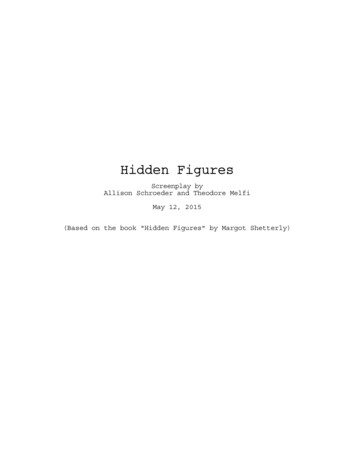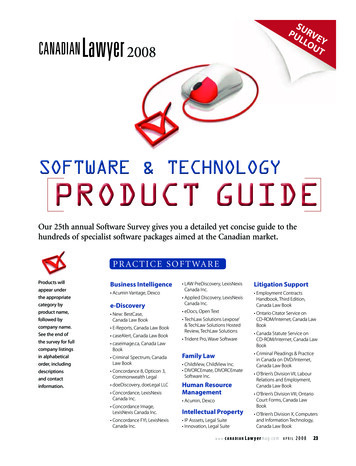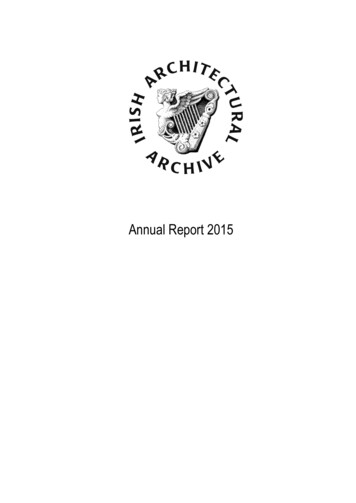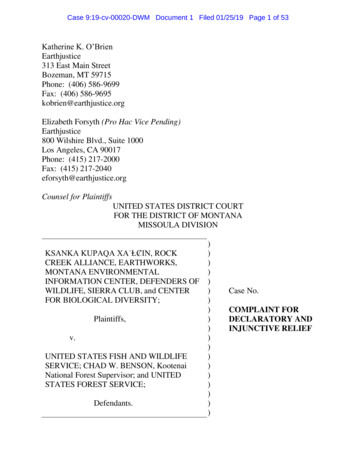
Transcription
Case 9:19-cv-00020-DWM Document 1 Filed 01/25/19 Page 1 of 53Katherine K. O’BrienEarthjustice313 East Main StreetBozeman, MT 59715Phone: (406) 586-9699Fax: (406) 586-9695kobrien@earthjustice.orgElizabeth Forsyth (Pro Hac Vice Pending)Earthjustice800 Wilshire Blvd., Suite 1000Los Angeles, CA 90017Phone: (415) 217-2000Fax: (415) 217-2040eforsyth@earthjustice.orgCounsel for PlaintiffsUNITED STATES DISTRICT COURTFOR THE DISTRICT OF MONTANAMISSOULA DIVISIONKSANKA KUPAQA XAʾⱠȻIN, ROCKCREEK ALLIANCE, EARTHWORKS,MONTANA ENVIRONMENTALINFORMATION CENTER, DEFENDERS OFWILDLIFE, SIERRA CLUB, and CENTERFOR BIOLOGICAL DIVERSITY;Plaintiffs,v.UNITED STATES FISH AND WILDLIFESERVICE; CHAD W. BENSON, KootenaiNational Forest Supervisor; and UNITEDSTATES FOREST SERVICE;Defendants.)))))))))))))))))))Case No.COMPLAINT FORDECLARATORY ANDINJUNCTIVE RELIEF
Case 9:19-cv-00020-DWM Document 1 Filed 01/25/19 Page 2 of 53INTRODUCTIONThis case challenges the failure of the U.S. Fish and Wildlife Service(“FWS”) and U.S. Forest Service to comply with the Endangered Species Act(“ESA”) in approving commencement of the Rock Creek Mine project, a majorindustrial copper and silver mine proposed in the unspoiled Cabinet Mountains ofnorthwest Montana.The Rock Creek Mine would tunnel beneath the Cabinet MountainsWilderness—one of the original wilderness areas designated by Congress underthe federal Wilderness Act and one of the region’s last undeveloped habitats forgrizzly bears and bull trout. Both grizzly bears and bull trout are listed asthreatened species under the ESA and both hold profound cultural and spiritualimportance for the Ktunaxa (Kootenai) people, in whose aboriginal territory themine would be built.The Rock Creek Mine would bring hundreds of people into the remoteproject area and involve mining and processing up to 10,000 tons of ore per day,seven days per week, for as long as 30 years, generating enough waste to fill aroughly 300-acre impoundment on the doorstep of the wilderness. The decadeslong project and its permanent industrial footprint would alter the wildernessenvironment forever and irreparably disturb land, waters, wildlife, and sources oftraditional foods and medicines that are sacred to the Ktunaxa people.1
Case 9:19-cv-00020-DWM Document 1 Filed 01/25/19 Page 3 of 53The ESA charges FWS and the Forest Service with ensuring that theRock Creek Mine would not jeopardize the continued existence of grizzly bears orbull trout. Plaintiffs—a coalition of traditional cultural leaders from the KsankaBand of the Ktunaxa Nation and local, regional, and national conservationorganizations—challenge the agencies’ failure to satisfy that fundamental statutoryduty.This is not the first time this Court has been called upon to remedy thedefendant agencies’ failures to comply with the ESA with regard to this project. In2005, this Court ruled that FWS’s prior biological opinion concluding that theRock Creek Mine would not jeopardize grizzly bears or bull trout violated theESA. Rock Creek All. v. U.S. Fish & Wildlife Serv., 390 F. Supp. 2d 993 (D.Mont. 2005) (“Rock Creek I”). FWS issued a new no-jeopardy biological opinionin 2006. This Court upheld FWS’s 2006 biological opinion but invalidated theForest Service’s authorization for the Rock Creek Mine based on its failure toadequately address project impacts on bull trout. Rock Creek All. v. U.S. ForestServ., 703 F. Supp. 2d 1152 (D. Mont. 2010) (“Rock Creek II”), aff’d 663 F.3d439 (9th Cir. 2011).In 2017, FWS and the Forest Service determined that they mustreinitiate formal consultation under the ESA concerning the mine’s impacts on bulltrout, based in part on the fact that the biological opinion upheld by this Court in2
Case 9:19-cv-00020-DWM Document 1 Filed 01/25/19 Page 4 of 532010 had failed to consider a major impact that mining would have on bull trout—namely, permanent dewatering of their stream habitat.However, despite repeated requests from Plaintiffs, FWS refused toreinitiate formal consultation regarding the mine’s impacts on grizzly bears toconsider significant new grizzly bear mortality data indicating that the mine’smitigation plan cannot rationally be relied upon to neutralize the substantialmortality risks the mine poses to grizzlies. Instead, in November 2017 FWS issueda supplement to its 2006 biological opinion in which it concluded—withoutacknowledging or considering the mortality data cited by Plaintiffs—thatreinitiation of ESA consultation concerning grizzly bear impacts is not warrantedand the agency’s 2006 no-jeopardy determination remains valid.In this case, Plaintiffs challenge that FWS determination and theagencies’ resulting failure to reinitiate ESA consultation regarding the mine’simpacts on grizzly bears. Plaintiffs also challenge the legality of FWS’s 2017 bulltrout biological opinion and the Forest Service’s authorization for the first phase ofthe project in reliance on the challenged FWS decisions.This Court also has had to step in to ensure the defendant agencies’compliance with their ESA obligations regarding the nearby Montanore Mine, asecond proposed copper and silver mine that threatens substantially the sameadverse effects on grizzly bears and bull trout as the Rock Creek Mine. In 2017,3
Case 9:19-cv-00020-DWM Document 1 Filed 01/25/19 Page 5 of 53this Court vacated the federal approvals for the Montanore Mine after determiningthat, among other legal violations, FWS had arbitrarily concluded that theMontanore project would not jeopardize grizzly bears or bull trout and the ForestService had unlawfully relied on those FWS determinations to authorize theproject. Save Our Cabinets v. U.S. Fish & Wildlife Serv., 255 F. Supp. 3d 1035(D. Mont. 2017).Despite the recent guidance provided by this Court, in their mostrecent approvals for the Rock Creek Mine, FWS and the Forest Service have againfailed to satisfy their ESA obligations. Specifically, the Defendants have violatedthe ESA by (1) ignoring evidence that the mine poses greater mortality threats togrizzly bears than the agencies assumed—evidence this Court held must beconsidered before the Defendants could approve the nearby Montanore Mine; (2)irrationally dismissing the Rock Creek mine’s permanent adverse impacts onimportant bull trout populations; and (3) relying on a metric for authorized “take”of bull trout that this Court found illegal in its 2017 Save Our Cabinets rulingaddressing the Montanore project. The agency decisions challenged in this casereflect the Defendants’ refusal to grapple with significant new evidence concerningthe Rock Creek Mine’s threats to protected wildlife and defy this Court’s rulings inSave Our Cabinets.4
Case 9:19-cv-00020-DWM Document 1 Filed 01/25/19 Page 6 of 53JURISDICTION AND VENUEPlaintiffs bring this action pursuant to the judicial review provisionsof the Administrative Procedure Act, 5 U.S.C. §§ 701-706, and the citizen suitprovision of the ESA, 16 U.S.C. § 1540(g), which waive the Defendants’ sovereignimmunity. As required by the ESA citizen suit provision, Plaintiffs sent FWS andthe Forest Service a 60-day notice of their intent to sue on August 28, 2018. Seeid. § 1540(g)(2)(A)(i). The Forest Service, in consultation with FWS, respondedby letter on October 23, 2018, but the Defendants have not remedied the legalviolations alleged in this complaint.This Court has jurisdiction over Plaintiffs’ claims under 16 U.S.C.§ 1540(g) and 28 U.S.C. § 1331 (federal question) and may issue a declaratoryjudgment and injunctive relief under 28 U.S.C. §§ 2201-2202.Venue lies in the District of Montana, Missoula Division, becauseplaintiff Ksanka Kupaqa Xaʾⱡȼin is based in Lake County, Montana; the lands atissue in this suit are located primarily in Sanders County, Montana; and asubstantial part of the events giving rise to Plaintiffs’ legal claims occurred in theDistrict of Montana. See 28 U.S.C. § 1391(e)(1); D. Mont. L.R. 1.2(c)(5).PARTIESPlaintiff Ksanka Kupaqa Xaʾⱡȼin (the Ksanka Crazy Dog Society) isan unincorporated organization based on the Flathead Indian Reservation in5
Case 9:19-cv-00020-DWM Document 1 Filed 01/25/19 Page 7 of 53Montana. Ksanka Kupaqa Xaʾⱡȼin is a traditional warrior society within theKsanka Band of the Ktunaxa (Kootenai) Nation. The society’s contemporarymembership consists of United States military veterans who play a leadership rolewithin the Ksanka community and serve as special stewards of their Nation’sspiritual and cultural traditions. Society members use the Cabinet MountainsWilderness and adjacent national forest lands, including areas threatened by theRock Creek Mine, for traditional cultural, spiritual, and subsistence activities;recreation; and family and community gatherings. The lands and waters threatenedby the Rock Creek Mine lie within the aboriginal territory of the Ktunaxa peopleand include areas of sacred importance to the Ksanka Kupaqa Xaʾⱡȼin and theirbroader community. The Ksanka Kupaqa Xaʾⱡȼin bear a unique responsibilitywithin their community to safeguard those lands and waters, and the wildlife theysupport, for future generations.Plaintiff Rock Creek Alliance (the “Alliance”) is a non-profitorganization with offices in Trout Creek, Montana, and Sandpoint, Idaho, that isdedicated to protecting the Clark Fork-Pend Oreille watershed and the CabinetMountains Wilderness from the adverse impacts of the proposed Rock CreekMine. Alliance members, board members, and staff live, own property, andrecreate in and around the Cabinet Mountains, including the wilderness andnational forest lands and associated waters threatened by the Rock Creek Mine.6
Case 9:19-cv-00020-DWM Document 1 Filed 01/25/19 Page 8 of 53Plaintiff Earthworks is a non-profit organization dedicated toprotecting communities and the environment from the adverse effects of mineraland energy development. Earthworks is headquartered in Washington, D.C., andhas field offices across the country, including Missoula, Montana. Earthworksmembers live and regularly recreate in northwest Montana, including the areas ofthe Cabinet Mountains threatened by development of the Rock Creek Mine.Plaintiff Montana Environmental Information Center (“MEIC”) is amember-supported non-profit organization dedicated to protecting and restoringMontana’s natural environment and protecting Montanans’ constitutional right to aclean and healthful environment. MEIC members recreate in and otherwise derivebenefit from the public lands and waters in the Cabinet Mountains that arethreatened by the Rock Creek Mine.Plaintiff Defenders of Wildlife (“Defenders”) is a national nonprofitconservation organization headquartered in Washington, D.C., with officesthroughout the country, including Missoula, Montana. Defenders has more than340,000 members, including roughly 1,500 in Montana. Defenders is a sciencebased advocacy organization focused on conserving and restoring native speciesand the habitat on which they depend, and has been involved in such efforts sincethe organization’s establishment in 1947. Defenders’ members and staff work andrecreate on public lands in the Cabinet Mountains that are threatened by the Rock7
Case 9:19-cv-00020-DWM Document 1 Filed 01/25/19 Page 9 of 53Creek Mine. In addition, Defenders has invested more than 600,000 toimplement more than 300 projects to reduce conflicts between humans and grizzlybears, including several in the Cabinet-Yaak grizzly bear recovery area where theRock Creek Mine is proposed.Plaintiff Sierra Club is a national nonprofit organization with 67chapters and roughly 3.5 million members and supporters, including approximately3,000 members in Montana, dedicated to exploring, enjoying, and protecting thewild places of the earth; to practicing and promoting the responsible use of theearth’s ecosystems and resources; to educating and enlisting humanity to protectand restore the quality of the natural and human environment; and to using alllawful means to carry out these objectives. Sierra Club members recreate in andvalue the Cabinet Mountains ecosystem and its public lands and waters for theirreplaceable wildlife and outstanding recreational opportunities they provide.Plaintiff Center for Biological Diversity (the “Center”) is a nonprofitorganization dedicated to the preservation, protection, and restoration ofbiodiversity, native species, and ecosystems. The Center was founded in 1989 andis based in Tucson, Arizona, with offices throughout the country. The Centerworks through science, law, and policy to secure a future for all species, great orsmall, hovering on the brink of extinction. The Center is actively involved inspecies and habitat protection issues and has more than 68,000 members8
Case 9:19-cv-00020-DWM Document 1 Filed 01/25/19 Page 10 of 53throughout the United States and the world, including 375 members in Montana.Center members recreate in and around the Cabinet Mountains on public landsthreatened by the proposed Rock Creek Mine.Plaintiffs have longstanding interests in the preservation and recoveryof bull trout and grizzly bears in the Northern Rocky Mountains region, includingthe Cabinet Mountains and broader Cabinet-Yaak ecosystem in northwestMontana. Over a period of decades, Plaintiffs have invested in the protection andrecovery of bull trout and grizzly bears in the region through a variety of actionsincluding public outreach and education, investment in conflict reductionmeasures, scientific analysis, advocacy, and when necessary, litigation. Plaintiffshave participated actively in available public comment processes concerning theproposed Rock Creek Mine and its effects on bull trout and grizzly bears, includingby filing extensive comments on the proposed and final environmental impactstatements and draft record of decision for the Rock Creek Mine issued by the U.S.Forest Service, and by submitting multiple requests to the agencies for ESAcompliant consultation regarding the mine’s impacts on grizzly bears and bulltrout.Plaintiffs’ members, staff, and volunteers use and enjoy the CabinetMountains Wilderness and surrounding national forest lands for a wide range ofactivities, including traditional cultural, subsistence, and spiritual practices;9
Case 9:19-cv-00020-DWM Document 1 Filed 01/25/19 Page 11 of 53recreational pursuits such as hiking, camping, backpacking, bird watching, andwildlife watching (including observation of bull trout and grizzly bears); as well asspiritual renewal and aesthetic enjoyment. Plaintiffs’ members, staff, and/orvolunteers have viewed bull trout and grizzly bears or signs of grizzly bearpresence in and around the Cabinet Mountains Wilderness and have engaged inextensive scientific, educational, and advocacy efforts aimed at maintaining ahealthy and intact ecosystem in the Cabinet Mountains that supports native fishand wildlife.By issuing biological opinions and a record of decision that allow theRock Creek Mine project to proceed in a manner that will harm threatened grizzlybears and bull trout in the Cabinet Mountains and without rationally ensuring thatthe project will not jeopardize those species, the Defendants will harm Plaintiffs’interests in viewing bull trout and grizzly bears and maintaining a healthy andintact ecosystem in the Cabinet Mountains that supports the full complement ofnative wildlife. Accordingly, the legal violations alleged in this complaint causedirect injury to the cultural, spiritual, aesthetic, conservation, recreational,scientific, educational, and wildlife preservation interests of the Plaintiffs and theirmembers, staff, and volunteers.Unless Plaintiffs’ requested relief is granted, the cultural, spiritual,aesthetic, conservation, recreational, scientific, educational, and wildlife10
Case 9:19-cv-00020-DWM Document 1 Filed 01/25/19 Page 12 of 53preservation interests of Plaintiffs and their members, staff, board members, andvolunteers will be adversely and irreparably injured by the Defendants’ failure tocomply with federal law. These are actual, concrete injuries that are traceable toDefendants’ conduct and would be redressed by the requested relief. Plaintiffshave no adequate remedy at law.Defendant U.S. Fish and Wildlife Service is an agency of the UnitedStates Department of Interior and is responsible for administering the ESA withregard to freshwater aquatic and terrestrial species, including bull trout and grizzlybears.Defendant Chad W. Benson is the acting United States ForestService Supervisor for the Kootenai National Forest, in which a majority of theactivities and environmental impacts associated with the Rock Creek Mine willoccur. The Kootenai National Forest Supervisor is identified as the responsiblefederal official for authorization and oversight of the mine project and signed thechallenged Record of Decision approving phase one of the project.Defendant U.S. Forest Service is an agency of the United StatesDepartment of Agriculture and is responsible for the management and protection ofthe Cabinet Mountains Wilderness and Kootenai National Forest. In that capacity,the Forest Service has jurisdiction and responsibility to authorize the Rock Creek11
Case 9:19-cv-00020-DWM Document 1 Filed 01/25/19 Page 13 of 53Mine project and ensure the project’s compliance with the ESA and otherapplicable laws.LEGAL BACKGROUND“The ESA is ‘the most comprehensive legislation for the preservationof endangered species ever enacted by any nation.’ It represents a commitment ‘tohalt and reverse the trend toward species extinction, whatever the cost.’” Ctr. forBiological Diversity v. Zinke, 900 F.3d 1053, 1059 (9th Cir. 2018) (quoting Tenn.Valley Auth. v. Hill, 437 U.S. 153, 180, 184 (1978)) (internal citation omitted).To that end, section 7(a)(2) of the ESA imposes on federal agenciessuch as the Forest Service a substantive duty to ensure that actions they authorizeor carry out are not likely to jeopardize listed species or destroy or adverselymodify critical habitat designated for such species. 16 U.S.C. § 1536(a)(2). Anagency action “jeopardizes” a protected species if it “reasonably would beexpected, directly or indirectly,” to reduce appreciably the species’ likelihood ofsurvival or recovery “by reducing the reproduction, numbers, or distribution of thatspecies.” 50 C.F.R. § 402.02; see Nat’l Wildlife Fed’n v. Nat’l Marine FisheriesServ., 524 F.3d 917, 932 (9th Cir. 2008) (holding that significant impairment ofspecies’ recovery prospects alone may constitute jeopardy).Before undertaking or authorizing an action that may affect ESAlisted species or their critical habitat, the Forest Service must consult with the12
Case 9:19-cv-00020-DWM Document 1 Filed 01/25/19 Page 14 of 53appropriate expert fish and wildlife agency, which is FWS in the case of grizzlybears and bull trout. See 16 U.S.C. § 1536(a)(2); 50 C.F.R. § 402.01(b). Theformal consultation process culminates in FWS’s issuance of a biological opinion,or “BiOp,” reflecting FWS’s determination—based on “the best scientific andcommercial data available”—of whether the proposed action will jeopardize alisted species or destroy or adversely modify designated critical habitat. 16 U.S.C.§ 1536(a)(2); see 50 C.F.R. § 402.14.If FWS concludes that a proposed action is likely to jeopardize a listedspecies, the action may not proceed. See 16 U.S.C. § 1536(a)(2). FWS mustdetermine whether a “reasonable and prudent alternative” exists that would avoidjeopardy. Id. § 1536(b)(3)(A).If FWS concludes that implementing a proposed action (or areasonable and prudent alternative) will not jeopardize a protected species but willnevertheless result in “take” of such species, the agency must issue an incidentaltake statement with its BiOp. 50 C.F.R. § 402.14(i)(1). Under the ESA, “take”means “to harass, harm, pursue, hunt, shoot, wound, kill, trap, capture, or collect” aprotected species “or to attempt to engage in any such conduct.” 16 U.S.C. §1532(19). Sections 9 and 10 of the ESA prohibit the taking of listed species unlessspecifically authorized in an incidental take statement. Id. §§ 1538(a)(1)(B), 1539.The amount of take authorized in an incidental take statement must provide an13
Case 9:19-cv-00020-DWM Document 1 Filed 01/25/19 Page 15 of 53effective “‘trigger’ that, when reached, results in an unacceptable level ofincidental take .” Ariz. Cattle Growers Ass’n v. U.S. Fish & Wildlife Serv., 273F.3d 1229, 1249 (9th Cir. 2001). In that circumstance, the protection from takeliability provided by the incidental take statement lapses and the federal agenciesmust re-initiate consultation to ensure that the actual extent of take resulting fromthe action will not jeopardize the affected species. Id.; see 50 C.F.R. § 402.16(a).The Forest Service violates the ESA if it approves or implements anaction in reliance on a legally flawed biological opinion or fails in its approval orimplementation decision “to discuss information that would undercut the[biological] opinion’s conclusion.” Ctr. for Biological Diversity v. U.S. Bureau ofLand Mgmt., 698 F.3d 1101, 1127-28 (9th Cir. 2012); accord Save Our Cabinets,255 F. Supp. 3d at 1063.The agencies’ ESA obligations do not end with FWS’s issuance of abiological opinion for a particular action, or with the Forest Service’s issuance ofan authorization for the action. Instead, the agencies must reinitiate formalconsultation where, among other circumstances, the amount of take authorized inthe incidental take statement is exceeded or where “new information reveals effectsof the action that may affect listed species or critical habitat in a manner or to anextent not previously considered.” 50 C.F.R. § 402.16. “The duty to reinitiateconsultation lies with both the action agency and the consulting agency.” Salmon14
Case 9:19-cv-00020-DWM Document 1 Filed 01/25/19 Page 16 of 53Spawning & Recovery All. v. Gutierrez, 545 F.3d 1220, 1229 (9th Cir. 2008)(citing 50 C.F.R. § 402.16). “Reinitiation of consultation requires the FWS to issue a new Biological Opinion before the agency action may continue.” Envtl.Prot. Info. Ctr. v. Simpson Timber Co., 255 F.3d 1073, 1076 (9th Cir. 2001) (citingMt. Graham Red Squirrel v. Madigan, 954 F.2d 1441, 1451 (9th Cir. 1992)).FACTUAL BACKGROUNDI.THE ROCK CREEK MINEThe Rock Creek Mine is a copper/silver mine project proposedbeneath and adjacent to the Cabinet Mountains Wilderness in northwest Montana.Today, the landscape comprising the Cabinet Mountains Wilderness andsurrounding national forest lands is characterized by unspoiled expanses ofglaciated peaks, forested valleys, and rivers and streams that are among the purestwaters in the continental United States. The area is part of the aboriginal territoryof the Ktunaxa Nation, and the specific areas threatened by the Rock Creek Mineinclude sites that are sacred to the Ktunaxa people and are used for traditionalspiritual, cultural, and subsistence purposes.The wilderness and national forest lands threatened by the mine arehome to countless plant species and abundant native wildlife, including mountaingoats, bighorn sheep, pikas, wolverines, elk, moose, deer, mountain lions, andwolves. In addition, those lands provide a last refuge for the imperiled Cabinet15
Case 9:19-cv-00020-DWM Document 1 Filed 01/25/19 Page 17 of 53Yaak grizzly bear population, and the streams that traverse those lands provide oneof the last remaining undeveloped habitats for the region’s imperiled population ofbull trout.In the midst of this wild landscape, the Rock Creek Mine projectproposes mining beneath the wilderness and constructing ore-processing,wastewater treatment, mine-waste storage, and other industrial facilities onadjacent lands. These facilities would process up to 10,000 tons of ore per day foras long as 30 years. Mining waste would be warehoused permanently on site in atailings storage facility covering more than 300 acres.Among other adverse environmental impacts, mine development ispredicted to permanently dewater streams in the project area—including streamsthat are occupied by, and are designated as critical habitat for, bull trout—andwilderness streams designated as “Outstanding Resource Waters” under Montanalaw. In addition, mine development would bring hundreds of people into theremote project area, increasing the risk of human-caused mortality of grizzly bears.FWS completed its first biological opinion for the Rock Creek Minein December 2000. At that time, FWS concluded that the project would jeopardizethe survival and recovery of grizzly bears, but not bull trout. In light of itsjeopardy determination for grizzly bears, FWS developed a reasonable and prudentalternative consisting of additional mitigation requirements intended to address the16
Case 9:19-cv-00020-DWM Document 1 Filed 01/25/19 Page 18 of 53combined threats to grizzlies from simultaneously developing both the Rock CreekMine and the Montanore Mine.In 2001, the Forest Service issued a record of decision approving theRock Creek project in reliance on FWS’s analysis. In March 2002, however, FWSwithdrew its biological opinion in response to litigation and the Forest Servicesubsequently withdrew its record of decision.FWS issued a second biological opinion for the Rock Creek Mine inMay 2003. In that decision, FWS concluded that the Rock Creek Mine would notjeopardize grizzly bears or bull trout and would not adversely modify bull troutcritical habitat proposed for designation in the area.The Forest Service issued another record of decision approving theproject in June 2003. But in March 2005, this Court ruled that the 2003 BiOpviolated the ESA and vacated the agencies’ approvals for the mine. Rock Creek I,390 F. Supp. 2d at 1011.FWS issued a third biological opinion for the Rock Creek Mine inOctober 2006, in which it again concluded that the mine project would notjeopardize grizzly bears or bull trout nor destroy or adversely modify bull troutcritical habitat. FWS supplemented that biological opinion for the first time inSeptember 2007 to address new information concerning conditions for grizzlybears in the project area and to correct and clarify aspects of its bull trout analysis.17
Case 9:19-cv-00020-DWM Document 1 Filed 01/25/19 Page 19 of 53The 2006 biological opinion was upheld in litigation, but this Court vacated andremanded the Forest Service’s approval of the project based on violations of theForest Service Organic Act and the National Environmental Policy Act (“NEPA”).See Rock Creek All. v. U.S. Forest Serv., Nos. CV 05-107-M-DWM and CV 08028-M-DWM, 2010 WL 1287604 (March 29, 2010).In March 2015, while the Forest Service’s remand process remainedpending, Rock Creek Alliance, Earthworks, and the Idaho Council of TroutUnlimited requested that FWS and the Forest Service reinitiate section 7consultation to consider new evidence concerning the mine’s impacts on grizzlybears and bull trout that had emerged in the roughly nine years since FWS issuedits 2006 BiOp. Specifically, the groups contended that reinitiation of consultationwas required for FWS to consider new information showing that (1) minedevelopment would reduce flows in Rock Creek and East Fork Bull River, whichwas not anticipated or analyzed in the 2006 BiOp and would result in take of bulltrout and permanent harm to their critical habitat; (2) restoration of fish passageover major dams in the Lower Clark Fork River watershed where the mine site islocated, which FWS determined is essential for bull trout recovery in the region,had not occurred as FWS anticipated in the 2006 BiOp; and (3) the number ofhuman-caused grizzly bear mortalities in the Cabinet-Yaak ecosystem had18
Case 9:19-cv-00020-DWM Document 1 Filed 01/25/19 Page 20 of 53increased between 2007-2015, despite implementation of the key mitigationmeasures called for in the 2006 BiOp to reduce such mortalities.FWS responded in May 2015, claiming that it cannot require theForest Service to reinitiate ESA consultation and that FWS and the Forest Servicewould determine through the Forest Service’s pending review under NEPAwhether reinitiation of consultation would be required.In March 2017, the Forest Service determined that reinitiation ofconsultation on the Rock Creek Mine was required in light of the new evidencethat mine development would permanently reduce stream flows in the Rock Creekand Bull River drainages as well as the designation of additional bull trout criticalhabitat in the project area in 2010.However, neither the Forest Service’s reinitiation request to FWS norFWS’s response indicated that the agencies would evaluate new informationconcerning the efficacy of mine mitigation measures for preventing grizzly bearmortalities. Accordingly, in August 2017, Rock Creek Alliance, Earthworks,Montana Environmental Information Center, Defenders of Wildlife, the IdahoCouncil of Trout Unlimited, Clark Fork Coalition, Sierra Club, and the Center forBiological Diversity sent FWS a letter requesting that the agencies expand theapparent scope of their consultation to address this information. In that letter, theconservation groups invoked this Court’s 2017 Save Our Cabinets ruling19
Case 9:19-cv-00020-DWM Document 1 Filed 01/25/19 Page 21 of 53invalidating the ESA analysis and authorizations for the Montanore Mine based onthe agencies’ failure to consider the very same data showing that a roll-out of thekey conflict reduction measures in that mine’s mitigation plan, which aresubstantially identical to those required for the Rock Creek project, had not yieldeda reduction in grizzly killings in the Cabinet-Yaak ecosystem. FWS neverresponded to the letter.Instead, in November 2017, FWS issued a revised biological opinionanalyzing the effects of the Rock Creek Mine on bull trout only. U.S. Fish &Wildlife Serv., Revised Biological Opinion on the Effects of the Rock Creek MineProject on Bull Trout and Designated Bull Trout Critical Habitat (Nov. 2017)(“2017 Bull Trout BiOp”). In its 2017 Bull T
benefit from the public lands and waters in the Cabinet Mountains that are threatened by the Rock Creek Mine. Plaintiff Defenders of Wildlife ("Defenders") is a national nonprofit conservation organization headquartered in Washington, D.C., with offices throughout the country, including Missoula, Montana. Defenders has more than
